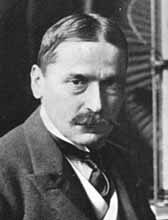EXHIBITS
HISTORY OF THE STONE CASTLE
Original Owner: Michael Pupin

In 1897 Michael Pupin bought the property known as Hemlock Farm on West Side Road and ten years later built this impressive stone house which still stands today, designed by Henry Hornbostel to evoke a country estate in Pupin’s native Serbia.
A brilliant electrical inventor and physicist, Michael Pupin immigrated to this country from his native Serbia at sixteen. He earned scholarships to Columbia University, Cambridge University, and the University of Berlin. He quickly rose through the ranks to his post as a Professor of Electro-mechanics at Columbia where the Pupin Physics Laboratory is named after him. Among his many inventions was the Pupin induction coil, which enabled long-distance transmission of telephone communication. In 1901 the Bell Telephone Company acquired the patent for more than one million dollars.
Michael Pupin won the Pulitzer Prize in letters in 1924 for his autobiography “From Immigrant to Inventor”.
Michael Pupin first came to Norfolk on the advice of his physician Dr. Frederic Dennis, a Norfolk summer resident, to recover from pneumonia and the untimely death of his wife. Dr. Dennis suggested to Pupin that the best medicine would be not only Norfolk’s bracing mountain air but also the activity of training two of his chestnut cobs, who became prize-winning show horses.
From his autobiography, ” From Immigrant to Inventor”:
“In 1897 I bought a farm at Norfolk. This blessed spot where I regained my health and happiness, became my real American home and I have never had any desire to seek a better haven of happiness in any other place.” —Michael I. Pupin
Architect: Henry Hornbostel

Henry Hornbostel (1867–1961) was an American architect. He designed more than 225 buildings, bridges, and monuments in the United States; currently, 22 are listed on the National Register of Historic Places.
Nearly half of his works (110) were in Pittsburgh, an industrial boomtown in the early twentieth century, where in 1904 he won the campus design competition for Andrew Carnegie’s Carnegie Technical Schools (today’s Carnegie Mellon University). He also helped to establish the Carnegie Mellon School of Architecture that same year. He also designed many of the original buildings of Emory University in Atlanta. A very moving film created to commemorate his contributions to the state of Architecture in America and his life is entitled “Henry Hornbostel in Architecture and Legacy”.
Bruderhof:
The Bruderhof is a group of people that renounce worldly goods and live in a communal community founded on the Christian Faith. They lived at 207 Westside Rd, Norfolk for many years until 1998 when the property was sold. They built many of the other buildings on the property. They had approximately 350 people living at this location at one time. They are a living example of practicing the Christian faith.
Confucian Study Association:
In 1998 the Confucian Study Association purchased the property. And in 2018 construction began for the Connecticut-Asia Cultural Center. Construction was completed in 2022 and the Cultural Center first opened its doors in August 2022. Today the Connecticut-Asia Cultural Center is open during specific times of the year for visitors to explore.
